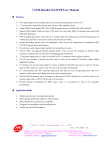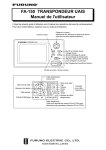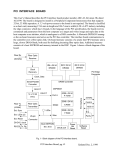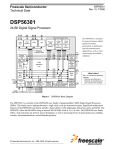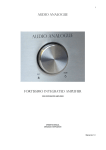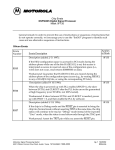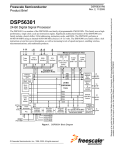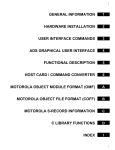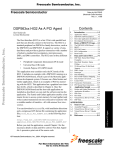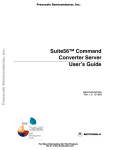Download ADM User`s manual
Transcript
DSP56305ADM User’s Manual Motorola, Incorporated Semiconductor Products Sector 6501 William Cannon Drive West Austin, TX 78735-8598 This document (and other documents) can be viewed on the World Wide Web at http://www.motorola-dsp.com. This manual is one of a set of three documents. You need the following manuals to have complete product information: Family Manual, User’s Manual, and Technical Data. OnCE is a trademark of Motorola, Inc. MOTOROLA INC., 1998 Order this document by D56305ADMUM/D Motorola reserves the right to make changes without further notice to any products herein to improve reliability, function, or design. Motorola does not assume any liability arising out of the application or use of any product or circuit described herein; neither does it convey any license under its patent rights nor the rights of others. Motorola products are not authorized for use as components in life support devices or systems intended for surgical implant into the body or intended to support or sustain life. Buyer agrees to notify Motorola of any such intended end use whereupon Motorola shall determine availability and suitability of its product or products for the use intended. Motorola and are registered trademarks of Motorola, Inc. Motorola, Inc. is an Equal Employment Opportunity /Affirmative Action Employer. ii DSP56305ADM User’s Manual MOTOROLA TABLE OF CONTENTS SECTION 1 QUICK START GUIDE. . . . . . . . . . . . . . . . . . . . . . . . . 1.2 REQUIRED USER-SUPPLIED EQUIPMENT . . . . . . . . . . . . . . 1.3 INSTALLATION PROCEDURE . . . . . . . . . . . . . . . . . . . . . . . . . 1.3.1 Preparing the DSP56305ADM . . . . . . . . . . . . . . . . . . . . . . . 1.3.2 Installing the DSP56305ADM . . . . . . . . . . . . . . . . . . . . . . . . 1.3.3 Installing the Software . . . . . . . . . . . . . . . . . . . . . . . . . . . . . . 1.3.4 Testing the DSP56305ADM Installation . . . . . . . . . . . . . . . . 1-1 1-4 1-4 1-5 1-8 1-9 1-9 SECTION 2 TECHNICAL SUMMARY . . . . . . . . . . . . . . . . . . . . . . . 2-1 2.1 DSP56305ADM BOARD ARCHITECTURE . . . . . . . . . . . . . . . . 2-3 2.2 DSP56305ADM FEATURES . . . . . . . . . . . . . . . . . . . . . . . . . . . 2-3 2.3 CONFIGURING THE DSP56305 ADM . . . . . . . . . . . . . . . . . . . 2-5 2.4 DSP56305ADM MEMORIES . . . . . . . . . . . . . . . . . . . . . . . . . . . 2-8 2.4.1 128K SRAM (With Option for 128K SRAM) . . . . . . . . . . . . . . 2-8 2.4.2 Optional 512K DRAM . . . . . . . . . . . . . . . . . . . . . . . . . . . . . 2-10 2.4.3 Flash PROM . . . . . . . . . . . . . . . . . . . . . . . . . . . . . . . . . . . . 2-11 2.5 DSP56305 OPERATING MODES . . . . . . . . . . . . . . . . . . . . . . 2-12 2.6 CLOCK SOURCE. . . . . . . . . . . . . . . . . . . . . . . . . . . . . . . . . . . 2-14 2.6.1 On-Board Clock Generator . . . . . . . . . . . . . . . . . . . . . . . . . 2-14 2.6.2 External Clock . . . . . . . . . . . . . . . . . . . . . . . . . . . . . . . . . . . 2-15 2.6.3 DSP56305 PLL Enable/Disable on Reset . . . . . . . . . . . . . . 2-16 2.7 HOST PORT SELECTION . . . . . . . . . . . . . . . . . . . . . . . . . . . . 2-17 2.7.1 ISA DMA and Interrupt Channel Configuration . . . . . . . . . . 2-17 2.7.2 PCI Operation . . . . . . . . . . . . . . . . . . . . . . . . . . . . . . . . . . . 2-19 2.8 CONNECTORS . . . . . . . . . . . . . . . . . . . . . . . . . . . . . . . . . . . . 2-20 2.8.1 Expansion and Logic Analyzer Connectors . . . . . . . . . . . . . 2-20 2.8.2 5 V Power Connector. . . . . . . . . . . . . . . . . . . . . . . . . . . . . . 2-23 2.8.3 HI32 Connector . . . . . . . . . . . . . . . . . . . . . . . . . . . . . . . . . . 2-23 2.8.4 SSI Port Connectors . . . . . . . . . . . . . . . . . . . . . . . . . . . . . . 2-23 2.8.5 SCI Port Connector . . . . . . . . . . . . . . . . . . . . . . . . . . . . . . . 2-25 2.8.6 JTAG/OnCE Connector . . . . . . . . . . . . . . . . . . . . . . . . . . . . 2-26 MOTOROLA DSP56305ADM User’s Manual iii APPENDIX A DSP56305 SCHEMATICS. . . . . . . . . . . . . . . . . . . . . . A-1 A.1 SCHEMATICS . . . . . . . . . . . . . . . . . . . . . . . . . . . . . . . . . . . . . . A-3 APPENDIX B DSP56305 BILL OF MATERIALS . . . . . . . . . . . . . . . B-1 B.1 BILL OF MATERIALS . . . . . . . . . . . . . . . . . . . . . . . . . . . . . . . . B-3 iv DSP56305ADM User’s Manual MOTOROLA LIST OF FIGURES Figure 1-1 Jumper Configuration—Front Side . . . . . . . . . . . . . . . . . . . . . . . . . . 1-7 Figure 1-2 Jumper Configuration—Back Side . . . . . . . . . . . . . . . . . . . . . . . . . . 1-8 Figure 1-3 Application Development. . . . . . . . . . . . . . . . . . . . . . . . . . . . . . . . . . 1-9 Figure 2-1 DSP56305ADM Block Diagram. . . . . . . . . . . . . . . . . . . . . . . . . . . . . 2-4 Figure 2-2 DSP56305ADM Top of Board . . . . . . . . . . . . . . . . . . . . . . . . . . . . . . 2-6 Figure 2-3 DSP56305ADM Bottom of Board . . . . . . . . . . . . . . . . . . . . . . . . . . . 2-7 Figure 2-4 128K SRAM Connection . . . . . . . . . . . . . . . . . . . . . . . . . . . . . . . . . . 2-9 Figure 2-5 512K DRAM Connection . . . . . . . . . . . . . . . . . . . . . . . . . . . . . . . . . 2-10 Figure 2-6 Flash PROM Connection. . . . . . . . . . . . . . . . . . . . . . . . . . . . . . . . . 2-11 Figure 2-7 DSP Mode Selection Block Diagram . . . . . . . . . . . . . . . . . . . . . . . . 2-12 Figure 2-8 U17 Socket Layout for 14-Pin and 8-Pin DIP Packages . . . . . . . . . 2-15 Figure 2-9 PLL Selection . . . . . . . . . . . . . . . . . . . . . . . . . . . . . . . . . . . . . . . . . 2-16 Figure 2-10 Expansion Connectors P2 and P5. . . . . . . . . . . . . . . . . . . . . . . . . . 2-21 Figure 2-11 Expansion Connector P6 and P8 . . . . . . . . . . . . . . . . . . . . . . . . . . 2-22 Figure 2-12 SSI—AIB Connector . . . . . . . . . . . . . . . . . . . . . . . . . . . . . . . . . . . . 2-24 Figure 2-13 Dedicated SSI Connectors . . . . . . . . . . . . . . . . . . . . . . . . . . . . . . . 2-25 Figure 2-14 SCI Dedicated Connector . . . . . . . . . . . . . . . . . . . . . . . . . . . . . . . . 2-25 Figure 2-15 JTAG/OnCE Connector . . . . . . . . . . . . . . . . . . . . . . . . . . . . . . . . . . 2-26 Figure A-1 SRAM Memory Bank #0 . . . . . . . . . . . . . . . . . . . . . . . . . . . . . . . . . . A-4 MOTOROLA DSP56305ADM User’s Manual v Figure A-2 Flash Memory. . . . . . . . . . . . . . . . . . . . . . . . . . . . . . . . . . . . . . . . . . A-5 Figure A-3 Optional SRAM Bank #1 . . . . . . . . . . . . . . . . . . . . . . . . . . . . . . . . . A-6 Figure A-4 DRAM Memory Bank . . . . . . . . . . . . . . . . . . . . . . . . . . . . . . . . . . . . A-7 Figure A-5 ISA Bus Buffers . . . . . . . . . . . . . . . . . . . . . . . . . . . . . . . . . . . . . . . . A-8 Figure A-6 PCI Connector . . . . . . . . . . . . . . . . . . . . . . . . . . . . . . . . . . . . . . . . . A-9 Figure A-7 JTAG, SCI, SSI, SSI–AIB Connectors . . . . . . . . . . . . . . . . . . . . . . A-10 Figure A-8 Interrupts—Mode Control and Clock Supply . . . . . . . . . . . . . . . . . A-11 Figure A-9 CPU . . . . . . . . . . . . . . . . . . . . . . . . . . . . . . . . . . . . . . . . . . . . . . . . A-12 Figure A-10 ISA Connector . . . . . . . . . . . . . . . . . . . . . . . . . . . . . . . . . . . . . . . . A-13 Figure A-11 Decoupling Capacitors . . . . . . . . . . . . . . . . . . . . . . . . . . . . . . . . . . A-14 Figure A-12 Expansions and Logic Analyzer Connectors . . . . . . . . . . . . . . . . . A-15 Figure A-13 5V–3.3V Power Regulator and Power up Reset Generator . . . . . . A-16 vi DSP56305ADM User’s Manual MOTOROLA LIST OF TABLES Table 1-1 DSP56305ADM Default Switch/Jumper Options . . . . . . . . . . . . . . . 1-6 Table 2-1 DSP56305 Card Default Switch/Jumper Options . . . . . . . . . . . . . . . 2-5 Table 2-2 DSP56305ADM Memories . . . . . . . . . . . . . . . . . . . . . . . . . . . . . . . . 2-8 Table 2-3 SRAM Configuration Jumper Settings. . . . . . . . . . . . . . . . . . . . . . . . 2-9 Table 2-4 DRAM Configuration Jumper Settings. . . . . . . . . . . . . . . . . . . . . . . 2-10 Table 2-5 Flash PROM Configuration Jumper Settings. . . . . . . . . . . . . . . . . . 2-11 Table 2-6 Operating Mode Selection. . . . . . . . . . . . . . . . . . . . . . . . . . . . . . . . 2-13 Table 2-7 Clock Source Selection Jumper Settings . . . . . . . . . . . . . . . . . . . . 2-14 Table 2-8 PLL Configuration Jumper Settings. . . . . . . . . . . . . . . . . . . . . . . . . 2-16 Table 2-9 ISA Bus DMA Channel Configuration . . . . . . . . . . . . . . . . . . . . . . . 2-17 Table 2-10 ISA Bus DMA Channel Configuration . . . . . . . . . . . . . . . . . . . . . . . 2-18 Table 2-11 ISA Bus Interrupt Selection . . . . . . . . . . . . . . . . . . . . . . . . . . . . . . . 2-18 Table 2-12 ISA Bus Interrupt Selection . . . . . . . . . . . . . . . . . . . . . . . . . . . . . . . 2-18 Table A-1 List of Schematics . . . . . . . . . . . . . . . . . . . . . . . . . . . . . . . . . . . . . . . A-3 Table B-1 Bill of Materials . . . . . . . . . . . . . . . . . . . . . . . . . . . . . . . . . . . . . . . . . B-3 MOTOROLA DSP56305ADM User’s Manual vii viii DSP56305ADM User’s Manual MOTOROLA LIST OF EXAMPLES Example 2-1 MOTOROLA PCI Boot Flash Program . . . . . . . . . . . . . . . . . . . . . . . . . . . . . . . . . 2-19 DSP56305ADM User’s Manual ix x DSP56305ADM User’s Manual MOTOROLA SECTION 1 QUICK START GUIDE MOTOROLA DSP56305ADM User’s Manual 1-1 Quick Start Guide 1.1 1.2 1.3 1-2 OVERVIEW . . . . . . . . . . . . . . . . . . . . . . . . . . . . . . . . . . . . . . . . 1-3 REQUIRED USER-SUPPLIED EQUIPMENT . . . . . . . . . . . . . . 1-4 INSTALLATION PROCEDURE . . . . . . . . . . . . . . . . . . . . . . . . . 1-4 DSP56305ADM User’s Manual MOTOROLA Quick Start Guide 1.1 OVERVIEW The Motorola Application Development System (ADS) is a tool used to design and test complex software applications and hardware products using a specific Motorola DSP chip. The related Application Development Modules (ADMs) contain the DSP chip and related hardware used for bench development and test. Detailed information about the content and use of the ADS is provided in the ADS User’s Manual (DSPADSUM/AD). This manual provides specific information about the DSP56305 Application Development Module (DSP56305ADM). This section provides a summary description of the DSP56305ADM, additional requirements, and quick installation information. Detailed information about the DSP56305ADM design and operation is provided in the remaining sections of this manual. Subsection 1.2 of this document gives a summary description of the equipment required to use the module with the Motorola ADS. Subsection 1.3 describes installation instructions, including: • Preparing the module for installation • Installing the module • Installing the software • Testing the installation Note: Detailed information about the design and operation of the DSP56305ADM is provided in this manual in Section 2 and Appendices A and B. MOTOROLA DSP56305ADM User’s Manual 1-3 Quick Start Guide Required User-Supplied Equipment 1.2 REQUIRED USER-SUPPLIED EQUIPMENT The following section gives a brief summary of the equipment required to use the DSP56305 Application Development Module (DSP56305ADM), some of which will be supplied with the module, and some of which must be supplied by the user. For use with the Motorola ADS (and the appropriate interface card), the user must supply one of the following host computer systems: • PC-compatible computer (486 class or higher) with: – MS-DOS version 6.0 or later, Windows 3.1 or later, or Windows 95 – Minimum 8 Mbytes RAM – One open 16-bit ISA expansion slot – One bank of free I/O addresses in the range of $100–$102, $200–202, or $300–$303 (no IRQ is required) – CD-ROM drive – Hard drive with 4 Mbytes of free disk space – Mouse • Sun Microsystems Sun 4 Workstation running Sun Operating System Release 4.1.1 or later (or Solaris Release 2.5 or later), one open SBus expansion slot, a CD-ROM drive, and a mouse • Hewlett Packard HP7xx Workstation running HPUX Version 9.x (Version 10.x is not supported), one open EISA expansion slot, a CD-ROM drive, and a mouse 1.3 INSTALLATION PROCEDURE Installation requires the following steps: 1. Preparing the DSP56305ADM board 2. Installing the module 3. Installing the software 4. Testing the installation 1-4 DSP56305ADM User’s Manual MOTOROLA Quick Start Guide Installation Procedure 1.3.1 Preparing the DSP56305ADM CAUTION Because all electronic components are sensitive to the effects of electrostatic discharge (ESD) damage, correct procedures should be used when handling all components in this kit and inside the supporting personal computer. Use the following procedures to minimize the likelihood of damage due to ESD: – Always handle all static-sensitive components only in a protected area, preferably a lab with conductive (anti-static) flooring and bench surfaces. – Always use grounded wrist straps when handling sensitive components. – Never remove components from anti-static packaging until required for installation. – Always transport sensitive components in anti-static packaging. This procedure describes configuring the DSP56305ADM board for use with its ISA bus interface. The board is factory configured as plug-in card for ISA bus operation. Refer to Host Port Selection on page 2-17 for other configurations. Locate the jumper blocks on the DSP56305ADM board, as shown in Figure 1-1 and Figure 1-2 on page 1-8. Verify their settings as shown in Table 1-1 on page 1-6. See the technical summary in Section 2 of this manual for additional information about the DSP56305ADM board and its components. MOTOROLA DSP56305ADM User’s Manual 1-5 Quick Start Guide Installation Procedure Table 1-1 Group DSP56305ADM Default Switch/Jumper Options Default Option Comment J1 Removed 512K words optional DRAM disabled J2 Removed 128K words optional SRAM disabled J3 Jumpered 128K words SRAM enabled J4, J5 J4—Removed J5 3–6,4–5 ISA DMA channel 5 selected J6 4–5 ISA Interrupt channel 10 selected JP1 1–2 ISA clamp protection is set JP2 Removed DSP PLL enabled JP3 ,JP4, JP5, JP6 Removed ISA host interface enabled JP7 Removed Flash memory disabled JP8 (located on bottom of board) 1–8 Sets clock source to clock generator SW3 SW3–2: ON SW3–1, 3, 4: OFF Bootstraps from Host ISA 1-6 DSP56305ADM User’s Manual MOTOROLA Quick Start Guide Installation Procedure JP5 3 2 1 JP3 JP2 JP1 JP6 J1 J2 JP4 J3 JP7 8 5 Not jumpered 8 8 5 5 SW3 J4 Jumpered 1 4 J5 1 4 ON OFF J6 1 4 1 2 3 4 Figure 1-1 Jumper Configuration—Front Side MOTOROLA DSP56305ADM User’s Manual 1-7 Quick Start Guide Installation Procedure 5 4 8 1 JP8 Figure 1-2 Jumper Configuration—Back Side 1.3.2 Installing the DSP56305ADM Figure 1-3 shows the interconnection diagram for connecting a PC to the DSP56305ADM board. Using the instructions in the ADS User’s Manual, connect the Command Converter to the DSP56305ADM board. Power for the DSP56305ADM is supplied from the Command Converter module. 1-8 DSP56305ADM User’s Manual MOTOROLA Quick Start Guide Installation Procedure 37-pin Interface Cable 14-pin Ribbon Cable User Application Circuits Host Computer Motorola DSP Host-Bus Interface Card Command Converter DSP56305ADM Figure 1-3 Application Development 1.3.3 Installing the Software Refer to the Motorola Application Development System User’s Manual for detailed instructions about installation and use of the ADS software. 1.3.4 Testing the DSP56305ADM Installation Once the DSP56305ADM is installed, it becomes a part of the Application Development System. Refer to the Motorola Application Development System User’s Manual for detailed information regarding evaluation and testing of an installed ADS system. MOTOROLA DSP56305ADM User’s Manual 1-9 Quick Start Guide Installation Procedure 1-10 DSP56305ADM User’s Manual MOTOROLA SECTION 2 TECHNICAL SUMMARY Preliminary MOTOROLA DSP56305ADM User’s Manual 2-1 Technical Summary 2.1 2.2 2.3 2.4 2.5 2.6 2.7 2.8 2-2 DSP56305ADM Board Architecture. . . . . . . . . . . . . . . . . . . . . . 2-3 DSP56305ADM Features . . . . . . . . . . . . . . . . . . . . . . . . . . . . . 2-3 Configuring the DSP56305 ADM . . . . . . . . . . . . . . . . . . . . . . . . 2-5 DSP56305ADM Memories. . . . . . . . . . . . . . . . . . . . . . . . . . . . . 2-8 DSP56305 Operating Modes. . . . . . . . . . . . . . . . . . . . . . . . . . 2-12 Clock Source . . . . . . . . . . . . . . . . . . . . . . . . . . . . . . . . . . . . . . 2-14 Host Port Selection . . . . . . . . . . . . . . . . . . . . . . . . . . . . . . . . . 2-17 Connectors . . . . . . . . . . . . . . . . . . . . . . . . . . . . . . . . . . . . . . . 2-20 DSP56305ADM User’s Manual MOTOROLA Technical Summary DSP56305ADM Board Architecture 2.1 DSP56305ADM BOARD ARCHITECTURE The DSP56305ADM is a versatile board that can be used as a stand-alone board or as an expansion card in a host computer with ISA or PCI expansion slots, and connected to other cards. The DSP56305 signals, power, and ground connections, are brought out to four 50-pin connectors for attaching additional boards or logic analyzers. In addition, separate connectors are provided for the on-chip peripheral ports—SCI, SSI, and JTAG/OnCE™. A dedicated connector is provided for audio applications. An overview description of the DSP56305 is also provided in the DSP56305 Product Information (DSP56305P/D) included with this kit. 2.2 DSP56305ADM FEATURES The DSP56305ADM provides the following features: • DSP56305 running at 80 MHz on board (socketed BGA package) • 128K fast static memory, one wait state access at 80 MHz (3.3V) • Option to add 128K fast static memory, 1 wait state access at 80 MHz (3.3V) • Option to add 512K dynamic memory (4–15 wait state access at 80 MHz (3.3V) • 64K Byte Flash PROM, on-board (3.3V) programmable • ISA/EISA bus compatible edge-connector (slave only operation) • PCI bus compatible edge-connector (master and slave operation) • Stand-alone or computer plug-in card operation • Integrated expansion and logic-analyzer connectors • Dedicated SSI ports connectors • Dedicated SCI port connector • JTAG/OnCE port connector • 5V operation, with on-board 3.3 V voltage regulation Note: Call your local Motorola sale office or distributor for additional information about the Motorola DSP Application Development System (ADS) kit. The ADS kit includes two additional boards: a Host Interface Card, and an external Universal Command Converter. The Host Interface Card plugs into the bus (on an IBM PC-compatible, HP7xx workstation, or Sun/Sun-compatible system) in the computer case. The Host Interface Card is connected via a 37-way ribbon cable to an external Universal Command Converter, which is then connected via a 14-way ribbon cable and the JTAG/OnCE port to the DSP56305ADM. The ADS is compatible only with Motorola software tools. MOTOROLA DSP56305ADM User’s Manual 2-3 Technical Summary DSP56305ADM Features Figure 2-1 shows the DSP56305ADM architecture. To achieve the best memory performance, no memory decoding is performed outside the DSP56305 chip, and the AA (Address Attribute) lines are used. There is a variety of jumpers options, for various memories configuration, to enable/disable each of the memory types on the DSP56305ADM. Expansion and Logic Analyzer Connectors Reset Clock Gen. Mode select 64K Byte Flash PROM (3.3V) AT29LV512 128K word (24) Static RAM MCM6926WJ10 × 3 DSP56305 Port A HI32 Port 128K WORD (24) Static RAM MCM6926WJ10 × 3 (Optional—not included) SCI Port SSI Ports OnCE Port 512K WORD (24) Dynamic RAM M5M4V4800CTP-8 × 3 (Optional—not included) OnCE Port and JTAG 5V to 3.3V voltage regulator ISA Edge Connector PCI Edge Connector SSI0, SSI1 Ports and AIB Interface SCI Port Figure 2-1 DSP56305ADM Block Diagram 2-4 DSP56305ADM User’s Manual MOTOROLA Technical Summary Configuring the DSP56305 ADM 2.3 CONFIGURING THE DSP56305 ADM Figure 1-1 and Figure 1-2 on page 1-8 show the physical locations of jumpers on the DSP56305ADM. Table 2-1 describes the default factory configuration for the DSP56305ADM jumper groups.: Table 2-1 DSP56305 Card Default Switch/Jumper Options Group Default Option Comment J1 Removed Disables 512K words optional DRAM memory J2 Removed Disables 128K words optional SRAM memory J3 Mounted Enables 128K words SRAM memory J4, J5 J4—no jumpers J5—3–6, 4–5 Sets ISA DMA channel 5 selected J6 4-5 Sets ISA Interrupt channel 10 JP7 Removed Disables Flash memory JP3, JP4, JP5, JP6 Mounted Enables ISA host interface JP1 1–2 Sets ISA clamp protection JP2 Removed Enables DSP PLL to run JP8 (located on back) 1–8 Selects clock source to clock generator. SW3 SW3-2: ON SW3-1,3,4: OFF Bootstraps from host ISA bus Figure 2-2 on page 2-6 shows the component placement on the front of the DSP56305ADM. Figure 2-3 on page 2-7 shows the component placement on the back of the DSP56305ADM. Note: The board is factory configured as plug-in card for ISA bus operation. Refer to Host Port Selection on page 2-17 for other configurations. MOTOROLA DSP56305ADM User’s Manual 2-5 Technical Summary Configuring the DSP56305 ADM Figure 2-2 DSP56305ADM Top of Board 2-6 DSP56305ADM User’s Manual MOTOROLA Technical Summary Configuring the DSP56305 ADM Figure 2-3 DSP56305ADM Bottom of Board MOTOROLA DSP56305ADM User’s Manual 2-7 Technical Summary DSP56305ADM Memories 2.4 DSP56305ADM MEMORIES Table 2-2 DSP56305ADM Memories Type Size Speed Voltage AA Line On Board SRAM 128K word (24-bit) 10 ns 3.3V AA0 Constant SRAM 128K word (24-bit) 10 ns 3.3V AA3 Optional DRAM 512K word (24-bit) 80 ns 3.3V AA2 Optional Flash 64K byte 200 ns 3.3V AA1 On Socket Note: 2.4.1 The first bank of SRAM and the Flash PROM are supplied as standard with the DSP56305ADM. The second SRAM bank and the DRAM are not included. All circuitry and associated components (decoupling capacitors, jumpers, etc.) are provided, with solder pads for mounting the optional SRAM and DRAM chips if desired. 128K SRAM (With Option for 128K SRAM) The SRAM on the DSP56305ADM is composed of a single bank of three chips of 128K × 8 SRAM, providing 128K words of 24-bit memory. These chips are MCM6926WJ10, a 3.3 v BiCMOS device with an access time of 10 nsec. The maximum load capacitance of each bank is 3 × 6 pF = 18 pF (address bus) and 8 pF (data bus). The 128K SRAM is accessed by the DSP56305 with one wait state when the DSP operates with an 80 MHz clock. Although devices with 12 ns access time are adequate for 80 MHz operation, a 10 ns device is used to enable operation at 100 MHz. The chip select to the onboard SRAM is generated using the DSP56305 AA0 line. The AA3 line selects the optional 128K block. The 128K SRAM connection is shown in Figure 2-4. SRAM bank 0 comprises a single bank of 3 chips of 128k X 8, 3.3 V devices, providing 128k 24-bit words. The chips used are Motorola MCM6926WJ10. This is a BiCMOS SRAM, 128k x 8, 3.3 V-only device, with an access time of 10 nS. The maximum load capacitance of each bank is 3 x 6 pf = 18 pF (address bus) and 8 pF (data bus). The SRAM is accessed by the DSP56305 with 1 wait-state when the DSP operates at 80 MHz clock. Although devices with 12 nS access time are acceptable for 80 MHz operation, the 10 nS device permits 1 wait state operation with 100 MHz versions of the DSP56305. The chip-select to SRAM bank 0 is generated using the DSP56305 signal AA0. The power supply to the MCM6926WJ10 is 3.3 V. SOJ packages are used. Schematic detail of SRAM connections is shown in Figure 2-4. 2-8 DSP56305ADM User’s Manual MOTOROLA Technical Summary DSP56305ADM Memories Space is provided to mount an additional 128 k words of SRAM as bank 1. Specifications and connection are identical to bank 0, except AA3 provides chip select for bank 1. Jumper J3 controls SRAM bank 0, and jumper J2 controls optional SRAM bank 1. When the jumper is inserted, the SRAM bank is enabled and the appropriate Address Attribute signal is used as Chip Select. When the jumper is removed, the SRAM bank is disabled and the Address Attribute signal can be used for other purposes. MCM6926WJ10 A(0:16) WR MCM6926WJ10 A(0:16) A(0:16) A(0:16) W W W U6 (U5) AA0 (Bank 0) AA3 (Bank 1) U12 (U11) U15 (U14) E E RD MCM6926WJ10 E G G DQ(0:7) G DQ(0:7) D(16:23) DQ(0:7) D(8:15) D(0:7) D(0:23) Figure 2-4 128K SRAM Connection The 128K SRAM is enabled and disabled using jumper J3. J2 is used to enable and disable the optional bank. When the appropriate jumper is installed, its corresponding bank of SRAM is enabled. When the jumper is not installed, the SRAM is disabled, and the AA0 line (or the AA3 line for the optional SRAM bank) can be used for other purposes. Note: Because of increased capacitance on the data and address lines if the optional SRAM bank is mounted, performance may be degraded. Table 2-3 SRAM Configuration Jumper Settings SRAM Configuration MOTOROLA J3 J2 SRAM Bank 0 Enabled 1 2 — SRAM Bank 0 Disabled 1 2 — SRAM Bank 1 Enabled — 1 2 SRAM Bank 1 Disabled — 1 2 DSP56305ADM User’s Manual 2-9 Technical Summary DSP56305ADM Memories 2.4.2 Optional 512K DRAM The 512K DRAM on the DSP56305ADM is composed of a single bank of three chips of 512K × 8, 3.3V,withan access time of 80 nsec. The DRAM chips are M5M4V4800CTP-8. The maximum load capacitance of each bank is 3 × 5 pf = 15 pF (address bus) and 7 pF (data bus). The 512K DRAM is accessed by the DSP56305 with four wait states when the DSP56305 is operating with an 80 MHz clock. The RAS signal to the 512K DRAM is generated using the DSP56305 AA2/RAS line. The 512K DRAM connection is shown in Figure 2-5. M5M4V4800CTP A(0:19) RD WR M5M4V4800CTP M5M4V4800CTP A(0:19) A(0:19) A(0:19) G G G W W W U4 U10 U13 CAS CAS CAS CAS AA2/RAS RAS RAS RAS DQ(0:7) D(16:23) DQ(0:7) DQ(0:7) D(8:15) D(0:7) D(0:23) Figure 2-5 512K DRAM Connection The 512K words DRAM is enabled and disabled using jumper J1. When J1 is installed, the DRAM bank is enabled. When J1 is not installed, the DRAM is disabled, and AA2 line can be used for other purposes. See Table 2-4 for DRAM jumper configuration. Table 2-4 DRAM Configuration Jumper Settings DRAM Configuration Note: 2-10 J1 DRAM Bank 0 Enabled 1 2 DRAM Bank 0 Disabled 1 2 Because of increased capacitance on the data and address lines if the optional DRAM bank is mounted, performance may be degraded. DSP56305ADM User’s Manual MOTOROLA Technical Summary DSP56305ADM Memories 2.4.3 Flash PROM To facilitate stand-alone operation of the DSP56305ADM, a Flash PROM is provided. The FPROM is on-board programmable, making it ideal for updates. Use is done with a byte wide, AT29LV512 3.3V only programmable (eliminating the need for additional supply or a DC-DC converter), 200 nsec access time. The low speed has no performance implications here, since the program is copied by the DSP56305 byte by byte to its internal memory and run from there. The load capacitance of this chip is 6 pF on the address lines and 12 pF (maximum) on the data lines. The flash memory can tolerate as many as 1000 program cycles per sector. Each sector is 128 bytes, for a total of 512 sectors. The AT29LV512 has a low-power write protect against inadvertent write during power transitions. It also features data polling during programming to shorten programming cycles. All actions to the device are controlled via a sequence of commands (except Read state, which the device enters after power-up), written to the device. The Flash PROM is connected to Port A of the DSP56305 as shown in Figure 2-6. AT29LV512 A(0:16) WR RD AA1 A(0:16) WE OE U16 CE DQ(0:7) D(0:7) Figure 2-6 Flash PROM Connection The Flash memory is enabled and disabled using jumper JP7. When JP7 is installed, the Flash memory is enabled. When JP7 is removed, the Flash is disabled, and the AA1 line can be used for other purposes. Table 2-5 Flash PROM Configuration Jumper Settings Flash PROM Configuration MOTOROLA JP7 Flash PROM Enabled 1 2 Flash PROM Disabled 1 2 DSP56305ADM User’s Manual 2-11 Technical Summary DSP56305 Operating Modes 2.5 DSP56305 OPERATING MODES All of the operating modes provided on the DSP56305 can be accessed on the DSP56305ADM. For detailed information on the se modes, please see the DSP56305 User’s Manual (DSP56305UM/D) and the DSP56300 Family Manual (DSP56300FM/D). During reset, the DSP56305 interrupt signals (IRQA–IRQD) are also used as the Mode Select signals (MODA–MODD). The DSP56305ADMuses SW3 to select the mode entered on exit from reset. Table 2-6 lists the available modes. Multiplexor U13 selects the signals presented on the DSP signals IRQA/MODA– IRQD/MODD. During reset (the RESET signal is asserted), the values selected on SW3 are passed to the DSP56305. The MODx signals are pulled high; closing a switch in SW3 pulls the corresponding MODx signal low. These values are sampled by the DSP56305 on the rising edge of RESET, and moved to the Operating Mode Register (OMR). This determines the mode in which the DSP56305 exits reset. During normal operation (RESET deasserted), U13 passes the interrupt signals, INTRA–INTRD, to the DSP56305 as IRQA–IRQD. RESET Interrupt Requests +3.3 V Initial Mode Select 1 To Interrupts of DSP56305 0 GND Figure 2-7 DSP Mode Selection Block Diagram 2-12 DSP56305ADM User’s Manual MOTOROLA Technical Summary DSP56305 Operating Modes Support is provided to enable DSP56305 to enter to all available modes via MODA/IRQA —MODD/IRQD and NMI/PINIT lines. These lines are sampled by the DSP56305 on the rising edge of the RESET signal. The sampled combination is moved to the Operating Mode Register (OMR). After RESET is deasserted, the mode selection lines are released, driven by pull up resistors and the MOD/IRQ signals are connected to IRQA, IRQB, IRQC, and IRQD lines. Table 2-6 Operating Mode Selection. SW3(1) MODA SW3(2) MODB SW3(3) MODC SW3(4) MODD 0—Expanded mode ON ON ON ON 1—RTOS Mode OFF ON ON ON 2—RTOS Mode ON OFF ON ON 3—RTOS Mode OFF OFF ON ON 4—(Reserved) ON ON OFF ON 5—(Reserved) OFF ON OFF ON 6—(Reserved) ON OFF OFF ON 7—(Reserved) OFF OFF OFF ON 8—Expanded mode ON ON ON OFF 9—Bootstrap from byte-wide memory OFF ON ON OFF A—Bootstrap through SCI ON OFF ON OFF B—(Reserved) OFF OFF ON OFF C—Host Bootstrap PCI Mode (32-bit-wide) ON ON OFF OFF D—Host Bootstrap 16-bit-wide UB Mode (ISA) OFF ON OFF OFF E—Host Bootstrap 8-bit-wide UB Mode in double-strobe pin configuration ON OFF OFF OFF F—Host Bootstrap 8-bit-wide UB Mode in single-strobe pin configuration OFF OFF OFF OFF Mode MOTOROLA DSP56305ADM User’s Manual 2-13 Technical Summary Clock Source 2.6 CLOCK SOURCE There are three clock sources on the DSP56305ADS: • Low cost on-board clock generator • External BNC connector • Crystal oscillator Table 2-7 Clock Source Selection Jumper Settings Clock Source JP8 Clock Generator 8 1 5 4 BNC Connector 8 1 5 4 Crystal Oscillator 8 1 5 4 The DSP56305ADM is configured for the on-board clock generator, with a DIP14 package, 33.0 MHz, 3.3 V clock generator, and a jumper linking JP8 pins 1–8. It is recommended that when the on-board clock generator is used, or when an external clock is provided through the BNC connector, the XTLD and COD bits in the PLL Control Register (PCTL) should be set. This helps avoid unnecessary on-board RFI. 2.6.1 On-Board Clock Generator The clock generator (U17) is mounted in a socket, allowing frequency selection by replacing the clock generator. The user may replace the clock generator with a generator of a different frequency . The PCB layout is designed such that it will accept both 14-pin and 8-pin DIP packages for the clock generator socket. The DSP56305ADM supports both 8-pin and 14-pin, 3.3 V clock generator modules. Locate the clock generator in the socket as shown inFigure 2-8. 2-14 DSP56305ADM User’s Manual MOTOROLA Technical Summary Clock Source 14 U17 13 12 11 10 8 7 14-pin DIP package 2 3 6 8 5 8-pin DIP package 1 1 9 4 2 5 3 6 4 7 Figure 2-8 U17 Socket Layout for 14-Pin and 8-Pin DIP Packages Note: The clock generator must be 3.3 V type. To select the on-board clock generator, JP8 should be jumpered from pin 1 to pin 8.The clock generator supplied with the DSP56305ADM is a 33 MHz oscillator in a 14-pin DIP package. 2.6.2 External Clock To support non-standard clock rates and frequency fine tuning, an external clock input via a BNC connector is furnished. Using this connector, an external 3.3 V clock generator (50 ohm impedance, DC coupled), may be connected to the DSP56305ADM. To avoid damage to the DSP, the external clock should be applied before the DSP56305ADM is powered on, and should be removed after the DSP56305ADM is powered off. CAUTION To avoid damage to the DSP56305 chip, ensure the DSP56305ADM is powered off when connecting or removing the external clock. To select the external clock generator, JP8 should be jumpered from pin 3 to pin 6. MOTOROLA DSP56305ADM User’s Manual 2-15 Technical Summary Clock Source 2.6.3 DSP56305 PLL Enable/Disable on Reset The DSP56305 samples the PINIT/NMI line on exit from the reset state to determine whether the PLL should be enabled or disabled. To enable the PLL, JP2 should not be jumpered. To disable the PLL, install a jumper on JP2.The principles of NMI Request and PLL INIT selection are shown in Figure 2-9. See Table 2-8. Table 2-8 PLL Configuration Jumper Settings Initial PLL Configuration JP2 PLL Enabled 1 2 PLL Disabled 1 2 During reset (RESET asserted), the level selected by JP2 is passed to the DSP by multiplexor U7. This level on NMI/PINIT is sampled by the DSP on the rising edge of RESET, and latched into the PEN bit of the PLL control register. During normal operation (RESET deasserted), multiplexor U7 passes the NMI signal to the DSP. See Figure 2-9. RESET NMI Request 1 To DSP56305 PINIT/NMI pin PLL INIT jumper 0 Figure 2-9 PLL Selection After the RESET line is deasserted, the PINIT/NMI signal is connected to the NMI signal. The DSP56305ADM is factory configured for PLL enabled (JP2 removed). 2-16 DSP56305ADM User’s Manual MOTOROLA Technical Summary Host Port Selection 2.7 HOST PORT SELECTION The DSP56305’s HI32 port supports the PCI bus with no n additional logic, while the ISA bus interface is supported with the addition of external buffers. To support application development on both platforms, DSP56305ADM supports both ISA and PCI environments. That is, the DSP56305ADM has edge connectors for both ISA and PCI, so the board can be plugged into any EISA/ISA or PCI host. The DSP56305ADM is factory configured for use with an ISA host. When the DSP56305ADM is used in an ISA host, the default setting is used, and JP3, JP4, JP5, and JP6 are jumpered. U18, U20, U21, U22, U23, RN2, and RN3 are mounted in their sockets. See Table 1-1 on page 1-6 for more information on jumper configuration. When the DSP56305ADM is used as a stand-alone device, JP3, JP4, JP5, and JP6 should be jumpered; U18, U20, U21, U22, U23, RN2, and RN3 should be mounted in their sockets. The same configuration should be used for an ISA host. When the DSP56305ADM is used in a PCI host, the jumpers on JP3, JP4, JP5, and JP6 should be removed. U18, U20, U21, U22, U23, RN2, and RN3 should be removed from their sockets. 2.7.1 ISA DMA and Interrupt Channel Configuration The DSP56305ADM enables the user to configure one of four channels for DMA and one of four interrupt channels for the ISA bus interface. Table 2-10 and Table 2-12 describe these configuration options. Table 2-9 ISA Bus DMA Channel Configuration DMA Channel MOTOROLA J4 J5 0 8 1 5 4 8 1 5 4 5 8 1 5 4 8 1 5 4 6 8 1 5 4 8 1 5 4 7 8 1 5 4 8 1 5 4 DSP56305ADM User’s Manual 2-17 Technical Summary Host Port Selection Table 2-10 ISA Bus DMA Channel Configuration DMA Channel J4 J5 0 — 1–8, 2–7 5 — 3–6, 4–5 6 3–6, 4–5 — 7 1–8, 2–7 — Table 2-11 ISA Bus Interrupt Selection Interrupt J6 5 8 1 5 4 6 8 1 5 4 7 8 1 5 4 10 8 1 5 4 Table 2-12 ISA Bus Interrupt Selection 2-18 Interrupt J6 5 3–6 6 2–7 7 1–8 10 4–5 DSP56305ADM User’s Manual MOTOROLA Technical Summary Host Port Selection 2.7.2 PCI Operation The PCI bus is designed to operate with boards at a 3:5 frequency relationship. The standard PCI bus operates at 33 MHz, so the DSP56305ADM is configured to operate at 55 MHz. The DSP56305 begins its boot routine after reset, which loads executable code from the Host to the board. When performed at 33 MHz, the boot routine located in the Bootstrap ROM is unable to change the Multiplication Factor (MF) in the PLL Control Register. The frequency relation of the PCI bus to the board is (3:3), and the DSP56305ADM cannot operate properly at this frequency ratio. To allow operation using the PCI, configure SW3 for the Flash Boot mode. The code in Example 2-1 must be programmed into the Flash memory. Following RESET, the DSP56305 enters Flash Boot mode and loads this program from the Flash memory. The program changes theDSP56305ADM’s initial frequency to the desired frequency, reconfigures the Operating Mode Register (OMR) for PCI configuration, and jumps to start of the boot routine. From this point, the DSP56305ADM performs its usual PCI operation. Example 2-1 PCI Boot Flash Program ;;;;;;;;;;;;;;;;;;;;;;;;;;;;;;;;;;;;;;;;;;;;;;;;;;;;;;;;;;;;;;;;;;;;;;;;;;;;; ;;;;;;;;;;;;;;;;;;;;;;;;;;;;; bootpci.asm;;;;;;;;;;;;;;;;;;;;;;;;;;;;;; ;;;;;;;;;;;;;;;;;;;;;;;;;;;;;;;;;;;;;;;;;;;;;;;;;;;;;;;;;;;;;;;;;;;;;;;;;;;;; ; ; ; ; ; Boot from FLASH program setting Chip Frequency to 80MHz, turning chip to PCI mode by jumping to PCI boot segment in bootstrap ROM. To receive SREC format do next: >>> asm56300 -a -b -l bootpci.asm >>> srec -b bootpci PLL_INIT_80 M_PCTL PCI_OP_MODE BOOT_START EQU $750013 EQU EQU EQU $FFFFFD $00000B $ff0000 ; PLL Initialization Word - 80 MHz ; PLL Control Register ; PCI mode configuration ; Starting address of bootstrap code ;***************************************************************************** ; First two words in FLASH: Program size and Load_Run start address. ;***************************************************************************** org p:$0,p:$0 dc $120 ; The size of program dc $000 ; Address in internal p: memory to load ; program from flash and start to run. MOTOROLA DSP56305ADM User’s Manual 2-19 Technical Summary Connectors Example 2-1 PCI Boot Flash Program ;************************************************************************ ; Main Program ;************************************************************************ org p:$0,p: ;************************************************************************ ; Initialize PLL ;************************************************************************ ;***************************************************************************** movep #PLL_INIT_80,x:M_PCTL ; Activate PLL move omr,a and #$FFFFF0,a or #PCI_OP_MODE,a ; set PCI mode move a,omr jmp 2.8 #BOOT_START ; go to the bootstrap code beginning CONNECTORS The DSP56305ADM provides the following connectors: • Expansion and logic analyzer connectors: 8 × 25 pin SMD pin-rows. • Power: 3 pin terminal block, two-part • HI32 port: ISA and PCI edge connectors • SSI I/F: Two connectors, 2 × 7 and 2 × 15 SMD pin-rows • JTAG/ OnCE port connector 2 × 7 SMD pin-rows 2.8.1 Expansion and Logic Analyzer Connectors To support hardware expansion and logic analyzer connection to the DSP56305ADM, a set of four dual-in-line 50-pin SMD connectors is provided. All the DSP56305 pins are routed to these connector. In addition, contains +3.3 v and GND pins are provided to facilitate hardware expansions powered by the DSP56305ADM. These connectors are connected to most of the pins of the DSP56305 chip. The signals that are not provided on these connectors are: PCAP, XTAL, EXTAL, MODA, MODB,MODC, MODD and PINIT. The pinout of these four connectors is shown in Figure 2-10 on page 2-21 and Figure 2-11 on page 2-22. 2-20 DSP56305ADM User’s Manual MOTOROLA Technical Summary Connectors GND 1 2 GND BL~ 3 4 STD0 5 TDI 7 V3.3 1 2 GND BS~ HAD12 3 4 HAD13 6 SC10 HAD14 5 6 HAD15 8 TCK HRST 7 8 HC1 TMS 9 10 TDO HCLK 9 10 HAEN SC20 11 12 DE~ HREQ~ 11 12 HPAR SC00 13 14 TRES~ GND 15 16 V3.3 V3.3 13 14 GND HIRQ 15 16 HWR~ 18 HDRQ SCK0 17 18 SRD1 HLOCK~ 17 SRD0 19 20 SCK1 CLAMP 19 SC21 21 22 STD1 GND 21 SC11 23 24 SC01 HTRDY~ 23 STX 25 26 GND GND 25 V3.3 27 28 HINTA~ GND 29 30 V3.3 HC2 29 30 HAD16 SCLK 31 32 SRX HAD18 31 32 HAD17 TIO0 33 34 TIO1 HAD19 33 34 GND TIO2 35 36 HAD0 V3.3 35 36 HAD20 HAD1 37 38 HAD2 HAD21 37 38 HAD22 HAD3 39 40 V3.3 HAD23 39 40 HC3 GND 41 42 HAD4 HAD24 41 42 HAD25 HAD5 43 44 HAD6 HAD26 43 44 HAD27 HAD7 45 46 HC0 HAD28 45 46 HAD29 HAD8 47 48 HAD9 HAD30 47 48 HAD31 20 HDEVSEL~ 22 V3.3 24 HFRAME~ 26 V3.3 HIRDY~ 27 28 HRD~ P5 P2 Figure 2-10 Expansion Connectors P2 and P5 MOTOROLA DSP56305ADM User’s Manual 2-21 Technical Summary Connectors BCLK 1 2 AA1 D23 V3.3 3 4 GND 6 V3.3 CLKOUT 5 6 AA0 8 D20 CAS~ 7 8 TA~ D18 9 10 D19 NMI~ 9 10 RESET~ D16 11 12 D17 V3.3 11 12 V3.3 D15 13 14 V3.3 GND 13 14 GND GND 15 16 D14 BB~ 15 16 BG~ D12 17 18 D13 BR~ 17 18 V3.3 D10 19 20 D11 GND 19 20 AA2 D9 21 22 V3.3 AA3 21 22 WR~ GND 23 24 V3.3 RD~ 23 24 GND GND 25 26 D8 V3.3 25 26 V3.3 D6 27 28 D7 GND 27 28 BCLK~ D4 29 30 D5 A0 29 D3 31 32 V3.3 INTRB~ 1 2 INTRA~ D22 3 4 D21 5 GND 7 30 A8 GND 31 32 V3.3 GND 33 34 D2 A1 33 34 A9 D0 35 36 D1 A2 35 36 A10 A22 37 38 A23 GND 37 38 V3.3 V3.3 39 40 V3.3 A3 39 40 A11 A20 41 42 A21 A4 41 42 A12 A18 43 44 A19 GND 43 44 V3.3 V3.3 45 46 V3.3 A5 45 46 A13 A16 47 48 A17 A6 47 48 A14 P8 P6 Figure 2-11 Expansion Connector P6 and P8 2-22 DSP56305ADM User’s Manual MOTOROLA Technical Summary Connectors 2.8.2 5 V Power Connector The 5 V power connector to the DSP56305ADM is a 3-lead two-part terminal block connector. This two-part connector provides these advantages: It is easily detachable from the board, and connecting wires to it does not affect the soldering quality of its receptacle to the PCB. The power connector is used only when the DSP56305ADM is used in stand-alone mode. If it is used in stand-alone mode, the power switch SW1 is used to turn the DSP56305ADM on and off. When installed in an ISA or PCI host, this switch is bypassed, and power is provided through the host interface connector. 2.8.3 HI32 Connector Two HI32 connectors are provided on the DSP56305ADM, a PCI edge connector, configured as 32-bit universal (5 V and 3.3 V) connector, and an ISA edge connector. These connectors are located on opposite sides of the DSP56305ADM, enabling its operation in ISA, EISA, and PCI systems. The PCI edge connector is keyed with both 5 v and 3.3 v keys to allow operation in both 5 V and 3.3 V PCI systems. 2.8.4 SSI Port Connectors The SSI port pins are provided on three different connectors: • The Expansion and Logic Analyzer connectors • Two dedicated SSI ports connectors • DSP56004AIB compatible connector The pins multiplication is to ease the connection of the SSI pins to various applications. The dedicated connectors are for general purpose use to be connected via a flat cable to another board. To avoid cross talk and to supply a constant impedance path for the ongoing signals, GND lines are inserted between the signal lines. To avoid incorrect insertion of the receptacle connector, keying is provided as one of the pins is cut and its corresponding hole in the receptacle connector is filled. MOTOROLA DSP56305ADM User’s Manual 2-23 Technical Summary Connectors The AIB interface connector supports the DSP56004AIB Audio Interface Board, which is a high-quality audio board with 2 stereo 18-bit ADCs and 3 stereo 18-bit DACs, originated for the DSP56004. The pinout of the independent SSI connectors and the AIB connector is shown in Figure 2-13 on page 2-25 and in Figure 2-12 on page 2-24. On the last figure, the most left column contains the AIB connector signals names, while the second to the left column, contains the DSP56305 signal names. When connected to the AIB card, the DSP56305ADM supports one stereo output channel and one stereo input channel. AIB Function SSI Function GPIO0 SRD1 1 2 GND GPIO1 STD1 3 4 GND GPIO2 SC01 5 6 GND GPIO3 SC11 7 8 GND SDI0 SRD0 9 10 GND SDI1 n.c. 11 12 GND RBICK SC00 13 14 GND RLRCK SC10 15 16 GND SDO0 STD0 17 18 GND SDO1 n.c. 19 20 GND SDO2 n.c. 21 22 GND TBICK SCK0 23 24 GND TLRCK SC20 25 26 GND RESET RESET 27 28 GND GND GND 29 30 GND Figure 2-12 SSI—AIB Connector 2-24 DSP56305ADM User’s Manual MOTOROLA Technical Summary Connectors SC00 1 2 GND SC01 3 4 GND SC10 5 6 GND SC11 7 8 GND SRD0 9 10 GND SRD1 11 12 GND KEY 13 14 GND Figure 2-13 Dedicated SSI Connectors 2.8.5 SCI Port Connector The SCI port pins are routed to two connectors: • Expansion and logic analyzer connectors • Dedicated SCI port connector Routing to the expansion - Logic-Analyzer connectors is done to support expansion boards and application debug while the dedicated connector enables connection to an application board via a flat cable. To avoid incorrect insertion of the receptacle connector, keying is provided as one of the pins is cut while its corresponding hole in the receptacle connector is filled. The pinout of the SCI dedicated connector is shown in Figure 2-14 on page 2-25. TXD 1 2 GND SCLK 3 4 GND RXD 5 6 KEY Figure 2-14 SCI Dedicated Connector MOTOROLA DSP56305ADM User’s Manual 2-25 Technical Summary Connectors 2.8.6 JTAG/OnCE Connector The JTAG/OnCE connector is used both for JTAG testing during production, and for OnCE functions for code debugging and software development. The pinout of the JTAG/OnCE dedicated connector is shown in Figure 2-15 on page 2-26. TDI 1 2 GND TDO 3 4 GND TCK 5 6 GND N.C. 7 8 KEY ORST~ 9 10 TMS +3.3V 11 12 N.C. DE~ 13 14 TRES~ Figure 2-15 JTAG/OnCE Connector 2-26 DSP56305ADM User’s Manual MOTOROLA APPENDIX A DSP56305 SCHEMATICS MOTOROLA DSP56305ADM User’s Manual A-1 DSP56305 Schematics A.1 A-2 SCHEMATICS . . . . . . . . . . . . . . . . . . . . . . . . . . . . . . . . . . . . . . A-3 DSP56305ADM User’s Manual MOTOROLA DSP56305 Schematics A.1 SCHEMATICS Table A-1 provides a list of the schematics included in this appendix. Table A-1 List of Schematics Figure Figure Name Page Figure A-1 SRAM Memory Bank #0 A-4 Figure A-2 Flash Memory A-5 Figure A-3 Optional SRAM Bank #1 A-6 Figure A-4 DRAM Memory Bank A-7 Figure A-5 ISA Bus Buffers A-8 Figure A-6 PCI Connector A-9 Figure A-7 JTAG, SCI, SSI, SSI–AIB Connectors A-10 Figure A-8 Interrupts—Mode Control and Clock Supply A-11 Figure A-9 CPU A-12 Figure A-10 ISA Connector A-13 Figure A-11 Decoupling Capacitors A-14 Figure A-12 Expansions and Logic Analyzer Connectors A-15 Figure A-13 5V–3.3V Power Regulator and Power up Reset Generator A-16 MOTOROLA DSP56305ADM User’s Manual A-3 Figure A-1 SRAM Memory Bank #0 A-4 DSP56305ADM User’s Manual MOTOROLA Figure A-2 Flash Memory MOTOROLA DSP56305ADM User’s Manual A-5 Figure A-3 Optional SRAM Bank #1 A-6 DSP56305ADM User’s Manual MOTOROLA Figure A-4 DRAM Memory Bank MOTOROLA DSP56305ADM User’s Manual A-7 Figure A-5 ISA Bus Buffers A-8 DSP56305ADM User’s Manual MOTOROLA Figure A-6 PCI Connector MOTOROLA DSP56305ADM User’s Manual A-9 Figure A-7 JTAG, SCI, SSI, SSI–AIB Connectors A-10 DSP56305ADM User’s Manual MOTOROLA Figure A-8 Interrupts—Mode Control and Clock Supply MOTOROLA DSP56305ADM User’s Manual A-11 Figure A-9 CPU A-12 DSP56305ADM User’s Manual MOTOROLA Figure A-10 ISA Connector MOTOROLA DSP56305ADM User’s Manual A-13 Figure A-11 Decoupling Capacitors A-14 DSP56305ADM User’s Manual MOTOROLA Figure A-12 Expansions and Logic Analyzer Connectors MOTOROLA DSP56305ADM User’s Manual A-15 Figure A-13 5V–3.3V Power Regulator and Power up Reset Generator A-16 DSP56305ADM User’s Manual MOTOROLA APPENDIX B DSP56305 BILL OF MATERIALS MOTOROLA DSP56305ADM User’s Manual B-1 DSP56305 Bill of Materials B.1 B-2 BILL OF MATERIALS . . . . . . . . . . . . . . . . . . . . . . . . . . . . . . . . B-3 DSP56305ADM User’s Manual MOTOROLA DSP56305 Bill of Materials B.1 BILL OF MATERIALS Table B-1 Bill of Materials Reference Value Description MSIL Cat. No. Total C1, C2, C4, C6, C8, C10, C11, C12, C13, C14, C15, C16, C17, C18, C19, C20, C21, C22, C23, C24, C25, C26, C27, C28, C29, C30, C31, C32, C33, C34, C35, C36, C37, C38, C40, C41, C42, C43, C45, C46, C48, C49, C50, C51, C52, C53, C54, C55, C56, C57 0.1 uF VCAP 021-00064 51 C3 100 uF/10 v DPCAP 023-00038 1 C5, C39 10 uF/20 v DPCAP 023-00027 2 C7 0.47 uF VCAP 021-00102 1 C9 390 pF VCAP 021-00089 1 C44, C47 22 pF/20% VCAP 021-00077 2 D1, D4, D5, D6, D7 1N4148 048-LL1N4148 5 D2 MBRD640CT 048-MBRD640CT 1 D3 1SMC5.0AT3 R1SDIO 048-1SMC5.0AT3 1 F1 on socket 5A Fuse 065-00025 015-00014 1 FR1, FR2 Ferrite 024-00013 2 J1, J2, J3, JP2, JP3, JP4, JP5, JP6, JP7 JMP2P 009-00165 9 J4, J5, J6 JH8 028-00148 3 JP8 JH8 009-00297 1 JP1 JMP3P 009-00165 1 LD1 yellow LED 048-01003 1 LD2 green LED 048-01001 1 P2, P5, P6, P8 Header (long pins) FC50CONN 028-00136 4 P3 PWR3 009-00213 1 P4 FC6CONN 028-00147 1 P7 BNC 009-00287 1 P9 FC30CONN 028-00143 1 MOTOROLA DSP56305ADM User’s Manual B-3 DSP56305 Bill of Materials Table B-1 Bill of Materials (Continued) Reference Value Description MSIL Cat. No. Total P10 FC14CONN 028-00149 1 P11—remove pin 8 FC14CONN 028-00149 1 R1, R10, R11 1 KΩ VRES 006-00257 3 R2 68 Ω VRES 006-00288 1 R3 243Ω VRES 006-00215 1 R4, R12 1MΩ VRES 006-00249 2 R5, R7, R8, R9, R13, R16 10KΩ VRES 006-00188 6 R6 51 Ω VRES 006-00221 1 R15 3.9MΩ /10% VRES 006-00297 1 R14 200KΩ/10% VRES 006-00298 1 RN1 10KΩ RN8 + VCC 051-00003 1 RN2 on socket 10K Ω RN8 + VCC 051-00003 009-00027 1 RN5 10K Ω RN14BUS 051-00046 1 RN3 on socket 1K Ω RN8 + VCC 051-00014 009-00027 1 RN4 1K Ω RN9 + VCC 051- 1 RN6 4700 RN14BUS 051-00036 1 SW1 Power On/Off 040-00032 1 SW2 Reset push button 040-00034 1 SW3 SPST4 040-00026 1 U1 74HCT00 051-74HCT00AD 1 U2 74LS05 051-74LS05D 1 U3 on 256-pin BGA socket DSP56305BGA 051- 1 U4, U10, U13 * M5M4V4800 3 U5, U11, U14 MCM6926 3 U6, U12, U15 MCM6926 3 U7, U19 74ACT157 051-74ACT157AD 2 U8 LT1086 051-LT1086CM 1 U9 MC1455 051-MC1455D 1 U16 on socket AT29LV512PLCC 051- 009-00259 1 B-4 DSP56305ADM User’s Manual MOTOROLA DSP56305 Bill of Materials Table B-1 Bill of Materials (Continued) Reference U17 on socket Value MSIL Cat. No. Total CLK_GEN_3V 8_14 009-00262 pin 1 U18, U20, U22 on socket 74HCT244 051-74HCT244 009-00290 3 U21, U23 on socket 74HCT245 051-74HCT245 009-00290 2 Crystal Oscillator 051- 1 Y1 Note: 33 MHz Description 32.768 kHz * Do not solder MOTOROLA DSP56305ADM User’s Manual B-5 DSP56305 Bill of Materials B-6 DSP56305ADM User’s Manual MOTOROLA




































































